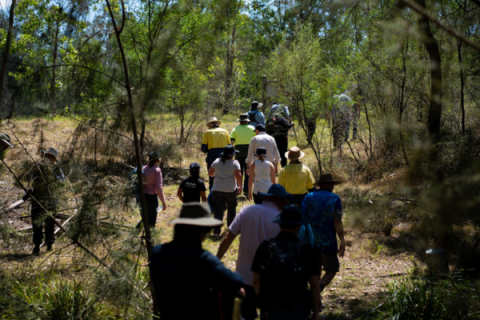It can be hard to spot the remnants of western Sydney’s agricultural past, but the most persistent legacy that remains on Wallaroo is the unwanted variety of weeds.
The Mulgoa Valley, in Sydney’s south-west, was once an important centre of agriculture for the early European settlers, and as a former grazing property Wallaroo has been left with large areas of exotic weeds and feral animals.
The 38-hectare site is protected by an in-perpetuity conservation agreement and is managed by the Cumberland Land Conservancy, a non-profit group of volunteers who work with the NSW Biodiversity Conservation Trust to conserve and restore native biodiversity.
Cumberland Land Conservancy President Wayne Olling said he was excited to see how far the property had come since 2016 when the conservation agreement was put in place. The agreement protects critically endangered Cumberland Plain Woodland and endangered River-flat Eucalypt Forest.
“This was formerly a grazing property so obviously managing invasive weeds is our biggest and most ongoing challenge,” Mr Olling said.
“Weeds can become very well established in a property like this, so it is an ongoing and costly process to control them, but thanks to NSW Biodiversity Conservation Trust grants and the hard work of volunteers and local conservation organisations we are managing to stay on top of that.
“There has been noticeable improvement in the riparian margins of Mulgoa Creek and further up the hills, so we know we are having an impact.”

The Cumberland Land Conservancy manages four properties in western Sydney and is dedicated to a single land management objective: the conservation and recovery of native flora and fauna in one of the most heavily cleared landscapes in Australia. Part of that mission is to connect large areas of land under conservation to provide a connected corridor.
“It's our belief that having connected corridors is the best way of sustaining viable populations of flora and fauna in western Sydney,” Mr Olling said.
“We are doing a lot of work to expand tree and shrub cover while maintaining suitable open structure for grassy woodland biodiversity.”
Mr Olling acknowledged that like all environmental restoration work, Wallaroo is a long-term, ongoing project, but with the increase in population and urban development in Western Sydney it is essential to provide protected habitat for the area’s native flora and fauna.
“It's definitely a comfort to us to know that whatever happens to each of the individual sites that make up the Cumberland Land Conservancy there is a conservation covenant on the land title that protects it for all time,” he said.
Indigenous Darug peoples managed the area known as the Cumberland Plain for more than 50,000 years. In managing Wallaroo for conservation, the Cumberland Land Conservancy and NSW Biodiversity Conservation Trust acknowledge the Traditional Owners and respect the Darug's heritage, past and present.
For more information about Wallaroo visit the Cumberland Land Conservancy website.